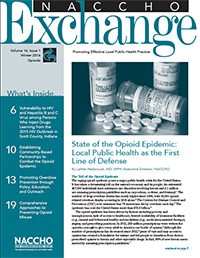 By Kate Lena, MPH, Linkages to Care Coordinator, AHOPE Needle Exchange Program, Boston Public Health Commission
By Kate Lena, MPH, Linkages to Care Coordinator, AHOPE Needle Exchange Program, Boston Public Health Commission
This is an excerpt from the 2017 NACCHO Exchange Winter Issue on opioids.
Opioid misuse is highly stigmatized and criminalized, making people who inject opioids an especially hard-to-reach, high-risk population and hampering public health surveillance efforts to understand the timing, circumstances, and proximate causes of overdose events. Boston Public Health Commission’s needle exchange program, AHOPE, has spent more than a decade working to overcome those obstacles. Launched in 2006, AHOPE—Massachusetts’s first community Overdose Education and Naloxone Distribution (OEND) pilot program—distributes harm reduction supplies to people who inject drugs.1
As part of its OEND programming, AHOPE collects and analyzes client input through overdose report-back forms covering key data points related to overdose event timing, circumstances, and location. Leveraging OEND program data to better understand the characteristics and geospatial dynamics of overdose events, AHOPE has been able to inform intervention efforts for opioid misuse using scarce resources and freely available technology.
Aims and Methods
This project had three main goals: (1) describe the characteristics of overdose events reported to AHOPE from May 2015 to April 2016; (2) conduct a geospatial analysis of the overdose events; and (3) create tools that could be used in the future to inform AHOPE and other public health programming and planning.
Results and Implications
From May 2015 through April 2016, AHOPE OEND participants used naloxone and other emergency response techniques to respond to 991 overdoses, 465 more than the previous year. Bystanders did not call 911 in 54% of those overdose events, and analysis found that help-seeking (i.e., calling 911) particularly fluctuated between January (61%) and April 2016 (34.5%). Using zip code data, staff mapped locations to identify target neighborhoods for overdose prevention. Spatiotemporal analysis also revealed considerable shifts in overdose hotspots across the study period.
AHOPE plans to use this information to inform future efforts, including new outreach sites, mobile van sites, and education campaigns, such as how to monitor overdose potential in public restrooms. Whether the distribution site is a syringe access program or a health center, timely and useable data related to overdose events can influence health officials’ planning and change the lives of program participants.
For the full article, download the 2017 winter issue of NACCHO Exchange at our bookstore.







